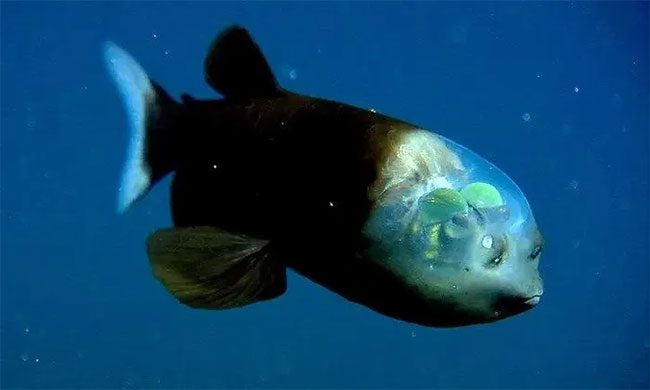At a depth of 600-800 meters (known as the twilight zone or mesopelagic zone), fish with transparent heads encasing their eyes look up like mesmerizing emerald orbs. These are massive spherical lenses perched atop a pair of long silver-colored eye tubes. They are the barreleye fish (Macropinna microstoma).
The green hue (actually derived from a yellow pigment) acts like sunglasses, helping them track their prey.
In the depths of the ocean, where there are no hiding spots, many animals have bioluminescent bellies for counter-illumination and self-defense. Bioluminescent prey is difficult to detect against the shimmering blue light filtering down from the sun. But the barreleye fish is one step ahead.

The barreleye fish has light-sensitive eyes that can rotate within a transparent dome. The two spots on its mouth resemble human nostrils. (Photo: Monterey Bay Aquarium Research Institute).
Bruce Robison, a deep-sea biologist at the Monterey Bay Aquarium Research Institute in California, states that the eye pigment of the barreleye fish allows them to distinguish between sunlight and bioluminescence. This ability enables the species to clearly see creatures attempting to camouflage themselves in the water.
The barreleye fish’s tubular eyes are highly sensitive and absorb a lot of light, making them advantageous in the dark depths of the ocean.
After years of observing dead and entangled fish, Bruce’s team has gained a deeper understanding of this species through a specialized remote-controlled camera.
“Suddenly, a light bulb went off, and I realized the issue. They can rotate their eyes,” he said. This means that barreleye fish can track prey as it drifts down in the water until it is right in front of them.
While observing a barreleye fish swimming in the deep sea, Bruce discovered something that other scientists had previously overlooked.
He remarked, “They have a protective dome over their eyes, similar to the nose of a jet plane,” pointing to the transparent part on their back, which had been torn from specimens he collected from the ocean.
This protective dome helps shield the barreleye fish’s eyes when they snatch food from the stinging tentacles of siphonophores — transparent creatures with dangerous long tentacles drifting in deep waters.
Inside the stomach of the barreleye fish, a mix of food has been found, including siphonophore tentacles and small crustaceans that are siphonophore prey, such as larval shrimp.
The hunting strategy of the barreleye fish is to swim towards siphonophores and nibble on small prey caught in their tentacles, using their transparent shield to protect their emerald eyes from stings.
However, finding barreleye fish in the wild is not an easy task.
In his 30-year career, Bruce has only seen this 15 cm long fish alive about eight times. “We spend a lot of time exploring underwater, so I can confidently say they are quite rare,” he said.


















































